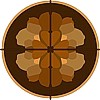Hello all,
I am making a headboard with a curved surface (profile shown in the attached JPG). I've already planed the convex surface, and have hogged out the concave part with a series of dado cuts, but need advice on getting the concave surface smooth and true.
The radius of the concave surface is about 32", and this will need to be cut the full length of the headboard, which is roughly 80". I've considered a scrub plane, but the radius of the blade is 3" and I'm not sure this is the best way to get it close enough for sanding and scraping. Plus, there is a lot of figure in the wood, and a scrub plane may tear out too much.
Any advice you may have is welcome.
Thanks in advance,
Joe





 Reply With Quote
Reply With Quote






